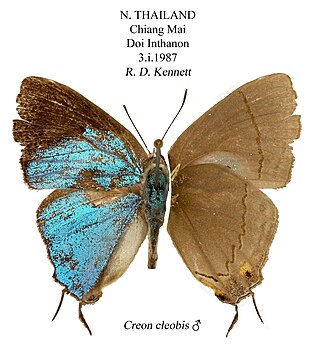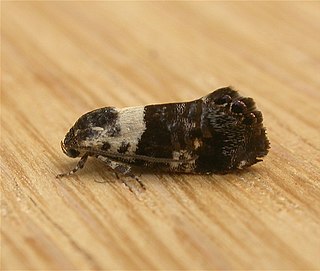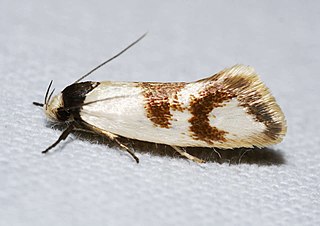
Hypolimnas misippus, the Danaid eggfly, mimic, or diadem, is a widespread species of nymphalid butterfly. It is well known for polymorphism and mimicry. Males are blackish with distinctive white spots that are fringed in blue. Females are in multiple forms that include male-like forms while others closely resemble the toxic butterflies Danaus chrysippus and Danaus plexippus.

Prosotas noreia, the white-tipped lineblue, is a species of lycaenid butterfly found in South Asia and Java.

Rapala lankana, the Malabar flash, is a species of lycaenid or blue butterfly found in South India and Sri Lanka. It was first described by Frederic Moore in 1879.

The broadtail royal is a butterfly in the monotypic genus Creon, in the family Lycaenidae. It is found in South Asia.

Eupselia aristonica is a species of moth of the family Depressariidae. It is found in Australia, where it has been recorded from New South Wales, the Australian Capital Territory, Victoria and Tasmania.

Grammodes stolida, the geometrician, is a moth of the family Erebidae. The species was first described by Johan Christian Fabricius in 1775. It is found in Africa, southern Europe, most of Asia and Australia. It migrates to central and northern Europe as far north as England, Denmark and Finland.
Trichoptilus scythrodes is a moth of the family Pterophoridae that can be found in Australia, including New South Wales and South Australia.

Trichoptilus ceramodes is a moth of the family Pterophoridae that is found in Australia, including New South Wales and South Australia.

Lichenaula lichenea is a species of moth of the family Xyloryctidae. It is known in Australia from the Australian Capital Territory, New South Wales and Queensland.
Hierangela erythrogramma is a moth in the family Gelechiidae. It is found in Burma.
Xylorycta chrysomela is a species of moth in the family Xyloryctidae. It was described by Oswald Bertram Lower in 1897. It is found in Australia, where it has been recorded from the Northern Territory and Queensland.
Eupselia callidyas is a moth in the family Depressariidae. It was described by Edward Meyrick in 1915. It is found in Australia, where it has been recorded from the Northern Territory.
Eupselia melanostrepta is a moth in the family Depressariidae. It was described by Edward Meyrick in 1880, where it has been recorded from Victoria and Tasmania.
Eupselia theorella is a moth in the family Depressariidae. It was described by Edward Meyrick in 1880. It is found in Australia, where it has been recorded from New South Wales.
Eupselia tristephana is a moth in the family Depressariidae. It was described by Edward Meyrick in 1915. It is found in Australia, where it has been recorded from Western Australia, the Northern Territory and Queensland.
Eupselia iridizona is a moth in the family Depressariidae. It was described by Oswald Bertram Lower in 1899. It is found in Australia, where it has been recorded from Victoria.
Eupselia philomorpha is a moth in the family Depressariidae. It was described by Oswald Bertram Lower in 1902. It is found in Australia, where it has been recorded from Victoria.
Hypertropha thesaurella is a moth in the family Depressariidae. It was described by Edward Meyrick in 1880. It is found in Australia, where it has been recorded from Queensland and New South Wales.

Antipterna trilicella is a species of moth in the family Oecophoridae, first described by Edward Meyrick in 1885 as Ocystola trilicella. It appears to be a moth endemic to Australia and confined to the east coast, occurring in Victoria, New South Wales and Queensland.
Antipterna diclethra is a species of moth in the family Oecophoridae, first described by Edward Meyrick in 1885 as Ocystola diclethra. Lectotypes for both Ocystola diclethra and Machaeretis niphoessa were both collected in greater Sydney, New South Wales.









